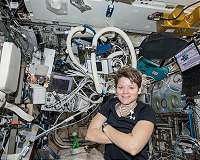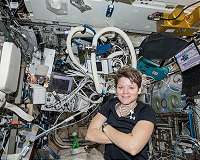When NASA astronaut Serena M. Aunon-Chancellor tested the operation of a sextant aboard the International Space Station, she quickly realized that using the centuries-old navigation instrument while traveling more than 17,000 miles per hour in microgravity would require some adjustments.
Early explorers on Earth used the instrument to navigate at sea by the stars, but their ships weren’t moving quite so fast.
Aunon-Chancellor, NASA astronaut Anne McClain, and ESA (European Space Agency) astronaut Alexander Gerst each used a sextant as a part of the Sextant Navigation investigation. The study demonstrated that a hand-held sextant could work well enough in space to serve as back-up navigation, particularly once astronauts figure out the right modifications.
On the ground, the astronauts trained for the experiment in “the dome,” essentially a mock-up of the space station’s largest window, the cupola. They were shown projections of stars with instructions to look for particular pairs to start their measurements.
“When we train on the ground, we are trying to picture what it is like to do something in space, but you really cannot unless you have been there before,” Aunon-Chancellor says. “On orbit, the actual stars are moving relative to the station’s field of view, and you don’t have much time. After the first few sessions, we asked the investigators to give us several star pairs, so if we were unable to catch one, we could move on to a different pairing.”
Scientists who send research to the space station often benefit from such in-orbit feedback by highly trained astronauts who crew the microgravity lab.
“Some experiments need to follow a precisely prescribed set of procedures, but others very much include crew member feedback as a vital part of the experiment itself,” says Sextant Navigation principal investigator Greg Holt, NASA Orion Navigation Lead at Johnson Space Center. “We knew that ours was one of those from the beginning and that the astronauts would be giving us a lot of feedback on how the experiment was run and on the instrument itself.”
Another challenge in using a typically Earth-based tool in orbit is maintaining stability while taking measurements. “In microgravity, you are in constant motion unless you restrain yourself. Learning how to move in space is something like learning a sixth sense,” Aunon-Chancellor said. “The investigators had ideas for how we could position ourselves to use the instrument, but we told them, we will figure it out and show you what worked.” Aunon-Chancellor, for example, found she could brace herself against the side of the cupola using her knees.
The sextant sighting technique is extremely flexible and can change as vehicle type and crews change, she adds. This and other studies are helping to determine whether a sextant is accurate enough to serve as back-up navigation for the Orion spacecraft, a key component of NASA’s Artemis program to explore the Moon in preparation for human missions to Mars. Once the instrument returns to Earth, Holt says investigators will use the astronauts’ feedback along with formal data to develop future versions for potential use on these missions.
Other sextant input or hacks provided by the astronauts include a scratch in the arc that is used to measure angles so they could identify the zero point with their thumbs in low light, Holt said. And while the first star charts were paper printouts, red-text versions on a tablet proved a better option. Those easily could be delivered electronically and used with red light headlamps to preserve the user’s night vision.
“We anticipated as much as we could beforehand, but there is nothing like actually having it up there and having crew members experiment with it to let us know what was working and what was not,” Holt says.
Potential future users of a sextant could benefit from what the astronauts learned during this investigation as well as from hundreds of years of history. Holt proposed the idea of navigating modern-day spacecraft with a sextant in 2012 after research and collaborative work with Emil Schiesser, who led Apollo navigation during the 1960s and 70s. Buzz Aldrin carried a handheld sextant on Gemini XII, and Apollo missions had one as an emergency crew return device.
“Alex and I are both big history buffs,” Aunon-Chancellor says. “We loved pulling out a non-powered piece of equipment that early explorers used to navigate, one that we can still use on the most modern machine that exists. That melding of past exploration techniques with future exploration questions was amazing.”
The space station’s Microgravity Science Glovebox (MSG), which provides a sealed environment to contain liquids and particles in microgravity for science and technology experiments, is another tool on station primed for astronaut adaptation.
“Scientists have ideas about how to do the experiment and where to put everything in the glovebox, but up there everything floats and we have to figure it out,” Aunon-Chancellor explains. “A lot of what we hack on-orbit for science is technique.”
Related Links
Space Station Research and Technology at NASA
Space Tourism, Space Transport and Space Exploration News
|
class=”BTX-AdSparc”>
|
|
Thanks for being there; We need your help. The SpaceDaily news network continues to grow but revenues have never been harder to maintain.With the rise of Ad Blockers, and Facebook – our traditional revenue sources via quality network advertising continues to decline. And unlike so many other news sites, we don’t have a paywall – with those annoying usernames and passwords.Our news coverage takes time and effort to publish 365 days a year.If you find our news sites informative and useful then please consider becoming a regular supporter or for now make a one off contribution. |
||
|
SpaceDaily Monthly Supporter $5+ Billed Monthly |
||
paypal only
SpaceDaily Contributor
$5 Billed Once
credit card or paypal
NASA concludes second spacewalk on historic mission
Washington DC (UPI) Jul 02, 2020
NASA concluded a spacewalk of 6 hours and 1 minute on Wednesday to replace aging batteries on the International Space Station.
NASA astronauts Bob Behnken and Chris Cassidy braved the extreme conditions of outer space for the second time in six days.
Three hours into the spacewalk, which started around 7:20 a.m, NASA reported that Wednesday’s battery work was completed. The astronauts also prepared the outside of the space station for the next spacewalk later this month, which is to replace … read more
– Advertisement –


